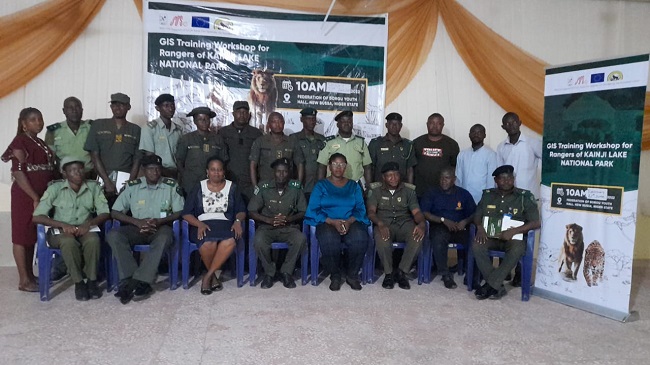As human-wildlife conflicts, poaching, illegal grazing, and logging persists, and endangered species are left at the brink of extirpation or extinction, stakeholders are devising numerous ways to address the unsavoury situation.

One of such entails the Nigerian Conservation Foundation (NCF) collaborating with the IUCN Save Our Species and the European Union to build the capacity of park rangers at a recent Geographical Information System (GIS) training workshop for Rangers of Kainji Lake National Park (KLNP).
The training is part of the ongoing project titled “Emergency Rescue of Nigeria’s Last Populations of West African Wildcats – Lion (Panthera leo) and Leopard (Panthera pardus)” in Kainji Lake National Park. The workshop held on Tuesday, June 21, 2022, in New Bussa, Niger State.
The project is designed to address the identified challenges of habitat degradation from unsustainable land use activities, animal poisoning and hunting pressure. The goal is to improve the conservation and range protection of lion and leopard in KLNP with 50% increase in park surveillance and 70% reduction in livestock invasion into the park by December 2023.
The training’s objective is to improve rangers’ capacity for monitoring and interpreting data using GIS for effective management decisions. Furthermore, rangers will be equipped with additional tools (drone, camera traps, GPS etc) to improve park surveillance and wildlife monitoring by December 2023.
Conservator of Park, CP Jimoh Oladosu while appreciating the initiative, said: “One of the benefits of the training is to improve on how to use some gadgets. We really appreciate NCF and IUCN for this initiative. It will make our rangers better and improve the park.”
Workshop facilitator and GIS expert, Dr. Michelle Fasona, in a statement, said: “The job of managing our national parks by rangers is usually challenging because of the nature of their work. The training on the use of GIS for rangers is a good initiative. The use of GIS techniques is a useful time-saving tool for rangers when surveying and gathering data from the field. The information gathered from the use of GIS can help park rangers to make more informed decisions when managing the park’s resources”
The Park is in Niger and Kwara states. It comprises two sectors; Borgu and Zugurma, which are separated by Kainji Lake, a lake impounded on the Niger River for hydroelectric power generation. The park is recognised as a Key Biodiversity Area (KBA) and one of the two sites in Nigeria with a viable population of lions. It is also the first National Park in the country.
The area is rich in biological diversity and harbour endangered species such as lions and leopards among other rich diversity like baboon, buffalo, waterbuck, reedbuck, duiker, warthog, hippopotamus, monkey, crocodile, birds, Costus spectabilis and species of reptiles.
The Borgu sector which is the sector currently being used for tourism purpose lies between Borgu and Baruten Local Government Areas of Niger and Kwara states and covers an area of 3,970 km2. It is bordered to the east by Kainji Lake and in the west by the Republic of Benin. Zugurma sector covers an area of 1370.89km2 and it is situated in Mashegu Local Government Area of Niger State.
The park is surrounded by different towns and villages which cut across different ethnic groups. Some of which are Bussa, Wawa, Kamberi, Kainji, Babana, Kaiama, Ibbi and Nupe, among others. The cultural occupation of the people is farming in guinea corn, maize, rice; cattle rearing; dyeing, blacksmithing, weaving, hunting, fishing, petty trading, and pottery making.
Dr. Stella Egbe, the project coordinator, in her remark, said: “KLNP is important as a Key Biodiversity Area and one of the only two sites with a viable population of lions in Nigeria amongst other rich biodiversity. However, the challenges of unsustainable anthropogenic practices threaten both the habitats and species within the park.
“With the support of the IUCN SOS funded by the EU, the Nigerian Conservation Foundation implementing these series of trainings and other activities to improve the conditions of the National Parks, improve rangers’ capacity and promote sustainable activities in communities surrounding the National Parks.”
Deforestation, illegal hunting, uncontrolled or indiscriminate bush burning, illegal grazing, unsustainable farming and human-wildlife conflict are identified problems the park is facing.
One of the participants at the training said: “The GIS training was very interesting and will go a long way in helping our work. Training and re-training will help us very well. This GIS training will help us locate on the map how to determine the location of some animals.”
